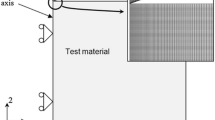Abstract
Indentation analysis based on the concept of representative strain offers an effective way of obtaining mechanical properties, especially work-hardening behavior of metals, from reverse analysis of indentation load–displacement data, and does not require measuring of the projected contact area. The definition of representative strain adopted in previous studies [e.g., Dao et al., Acta Mater. 49, 3899 (2001)] has a weak physical basis, and it works only for a limited range in some sense of engineering materials. A new indentation stress-state based formulation of representation is proposed in this study, which is defined as the plastic strain during equi-biaxial loading. Extensive numerical analysis based on the finite element method has shown that with the new formulation of representative strain and representative stress, the critical normalized relationship between load and material parameters is essentially independent of the work-hardening exponent for all engineering materials, and the results also hold for three distinct indenter angles. The new technique is used for four materials with mechanical properties outside the applicable regime of previous studies, and the reverse analysis has validated the present analysis. The new formulation based on indentation stress-state based definition of representative strain has the potential to quickly and effectively measure the mechanical properties of essentially all engineering materials as long as their constitutive behavior can be approximated into a power-law form.
Similar content being viewed by others
Change history
03 March 2011
An Erratum to this paper has been published: https://doi.org/10.1557/jmr.2006.0319
References
W.C. Oliver and G.M. Pharr: An improved technique for determining hardness and elastic-modulus using load and displacement sensing indentation experiments. J. Mater. Res. 7, 1564 (1992).
F. Doerner and W.D. Nix: A method for interpreting the data from depth-sensing indentation instruments. J. Mater. Res. 1, 601 (1986).
G.M. Pharr: Measurement of mechanical properties by ultra-lowload indentation. Mater. Sci. Eng. A 253, 151 (1998).
G.M. Pharr and A. Bolshakov: Understanding nanoindentation unloading curves. J. Mater. Res. 17, 2660 (2002).
J.J. Vlassak and W.D. Nix: Measuring the elastic properties of anisotropic materials by means of indentation experiments. J. Mech. Phys. Solids 42, 1223 (1994).
K.L. Johnson: Contact Mechanics (Cambridge University Press, Cambridge, U.K., 1985).
X. Chen and J.J. Vlassak: Numerical study on the measurement of thin film mechanical properties by means of nanoindentation. J. Mater. Res. 16, 2974 (2001).
R.B. King: Elastic analysis of some punch problems for a layered medium. Int. J. Solids Struct. 23, 1657 (1987).
J.C. Hay, A. Bolshakov, and G.M. Pharr: A critical examination of the fundamental relations used in the analysis of nanoindentation data. J. Mater. Res. 14, 2296 (1999).
N.A. Fleck and J.W. Hutchinson: Strain gradient plasticity. Adv. Appl. Mech. 33, 295 (1997).
Y.T. Cheng and C.M. Cheng: Scaling approach to conical indentation in elastic-plastic solids with work hardening. J. Appl. Phys. 84, 1284 (1998).
Y.T. Cheng and C.M. Cheng: Scaling, dimensional analysis, and indentation measurements. Mater. Sci. Eng. R44, 91 (2004).
S.D. Mesarovic and N.A. Fleck: Spherical indentation of elasticplastic solids. Proc. R. Soc. London A455, 2707 (1999).
L. Wang and S.I. Rokhlin: Universal scaling functions for continuous stiffness nanoindentation with sharp indenters. Int. J. Solids Struct. 42, 3807 (2005).
L. Wang, M. Ganor, and S.I. Rokhlin: Inverse scaling function in nanoindentation with sharp indenters: Determination of material properties. J. Mater. Res. 20, 987 (2005).
A.G. Atkins and D. Tabor: Plastic indentation in metals with cones. J. Mech. Phys. Solids 13, 149 (1965).
M. Dao, N. Chollacoop, K.J. VanVliet, T.A. Venkatesh, and S. Suresh: Computational modeling of the forward and reverse problems in instrumented sharp indentation. Acta Mater. 49, 3899 (2001).
N. Ogasawara, W. Makiguchi, and N. Chiba: Plastic properties determination method using triangular pyramid indenters based on elastic solution and rigid/perfectly plastic solution. Trans. Jpn. Soc. Mech. Eng. (2005, in press).
I.N. Sneddon: The relationship between load and penetration in the axisymmetric Boussinesq problem for a punch of arbitrary profile. Int. J. Eng. Sci. 3, 47 (1965).
F.J. Lockett: Indentation of a rigid/plastic material by a conical indenter. J. Mech. Phys. Solids 11, 345 (1963).
N. Ogasawara, W. Makiguchi, and N. Chiba: Plastic properties determination method for power-law hardening material using plural triangular pyramid indenters. Trans. Jpn. Soc. Mech. Eng. 70, 1529 (2004).
J.L. Bucaille, S. Stauss, E. Felder, and J. Michler: Determination of plastic properties of metals by instrumented indentation using different sharp indenters. Acta Mater. 51, 1663 (2003).
N. Chollacoop, M. Dao, and S. Suresh: Depth-sensing instrumented indentation with dual sharp indenters. Acta Mater. 51, 3713 (2003).
Y.P. Cao and J. Lu: A new method to extract the plastic properties of metal materials from an instrumented spherical indentation loading curve. Acta Mater. 52, 4023 (2004).
M.F. Ashby and D.R.H. Jones: Engineering Materials I (Butterworth Heinemann, Boston, MA, 1996).
M.F. Ashby: Material Selection in Mechanical Design (Butterworth Heinemann, Boston, MA, 1999).
ANSYS, Ansys Release 8.0 Documentation. (ANSYS Inc., Canonsburg, PA 2003).
ABAQUS, ABAQUS 6.4 User’s Manual. (ABAQUS Inc., Pawtucket, RI, 2004).
F.P. Bowden, and D. Tabor, The Friction and Lubrications of Solids (Oxford University Press, Oxford, U.K., 1950).
Author information
Authors and Affiliations
Corresponding author
Rights and permissions
About this article
Cite this article
Ogasawara, N., Chiba, N. & Chen, X. Representative strain of indentation analysis. Journal of Materials Research 20, 2225–2234 (2005). https://doi.org/10.1557/JMR.2005.0280
Received:
Accepted:
Published:
Issue Date:
DOI: https://doi.org/10.1557/JMR.2005.0280




